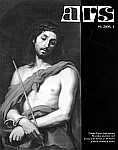
Časopis ARS 39 (2006) 1
Daniel GRÚŇ
Zmysel negácie. Nefiguratívny výtvarný prejav a avantgardné princípy v teórii Oskára Čepana[Meaning of Negation. Nonfigurative Art and Avant-Garde Principles in Oskár Čepan’s Art Theory]
(Resumé)
During the 1960s, literary theorist and historian Oskár Čepan (1925 – 1992) developed theoretical devices for the interpretation of abstract art, analysing works by the Bratislava artistic group Konfrontácie. At the same time, he examined Russian Constructivism and Suprematism (the abstract creations and writings of Kazimir Malevitch and Vladimir Tatlin) and works by Russian emigrants Vasily Kandinsky and Sergei Charchoun. His concern with the primary language and signs of visual abstraction attracted him to becoming a critic of contemporary Slovak abstract artists. The subject of my study deals with the style, methodological foundations and motivations of Oskár Čepan’s interpretations of abstract works of art. The marginal position of his essays within the Slovak art criticism of the decade does not mean that they are historically unimportant or lower quality. One must consider them within the officially-favored notion of art and cultural policy in communist Czechoslovakia, which did not support the theory and practice of abstract art. Furthermore, monographical studies on works of Rudolf Fila, Marián Čunderlík and Vladimir Tatlin were prohibited from being published at the beginning of the 1970s.
One of the study’s initial proposals is an examina¬tion of the relation of avant-garde principles to the formalist method, focusing on composition, structure, material qualities and the function of the artwork. My aim is to clarify the continuity of interpretative vehicles developed by the Prague Lingvistic Group, particularly in studies of Jan Mukařovský and Roman Jacobson. These vehicles were implemented by Oskár Čepan in combination with the terms of late Freudian psychoanalysis and the notion of montage, which came from Russian avant-garde film maker and theorist Sergei Eisenstein. In order to comprehend the way Oskár Čepan composes the language of abstract art and its theoretical foundations, I analyse central terms of his theory and their employment. I focus on his notion of the nonfigurative picture as a system of sign representation, the device of which is the semantic quality of painterly gesture. This gesture, according to Čepan, carries not only the expression and meaning of the picture, but also reflects independence of the creative artist’s subject and keeps the outer world under control. Oskár Čepan elaborated on the theory of painterly gesture in his essay on works of Rudolf Fila entitled “Painter between Eros and Thanatos”, which is regarded as the most profound monographical analysis of the period. The central argument for analysing abstract artwork is his claim that the language of abstraction is universal, having human dimensions and human perspective. This demand for universality was elaborated under the term “anthropological constant” in his interpretations of works by Slovak abstract artists.
My analysis of Oskár Čepan’s most important studies is provided in comparison to art criticism of the decade and research of other scholars in the field of Russian avant-gardes in Czechoslovakia. In particular, I concentrate on analogies between his theory of modern literature, published in book “Literary Bagatelles”, and steps of his interpretation regarding abstract art. For Oskár Čepan, the motif of negation represents the decline of traditional aesthetic systems and the proposition of new ones and seems to be crucial for his theory. Negation is also related to the construction of artwork as well the term montage as a guarantee of avant-garde principals in the sphere of literature and visual arts. In conclusion, it is important to ask why is it important to the history of Slovak art to write this kind of interdisciplinary study. On one hand, Čepan in his writings developed something like a realm of freedom; on the other hand, although rather marginal and fragmentary, his theory represents an interesting contribution to the comparative study of visual images and words for the period of late modernism in East-Central Europe.
English by author